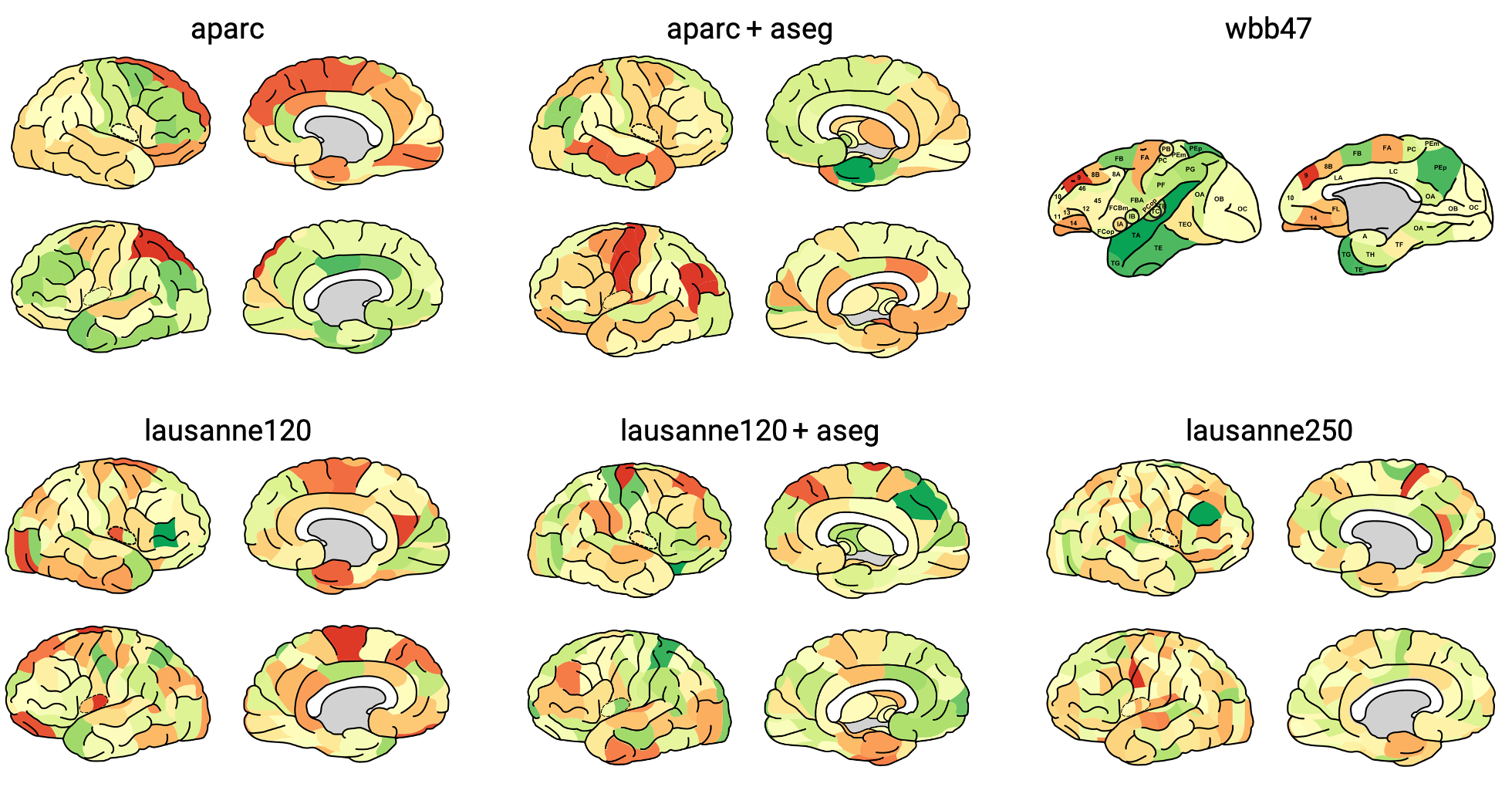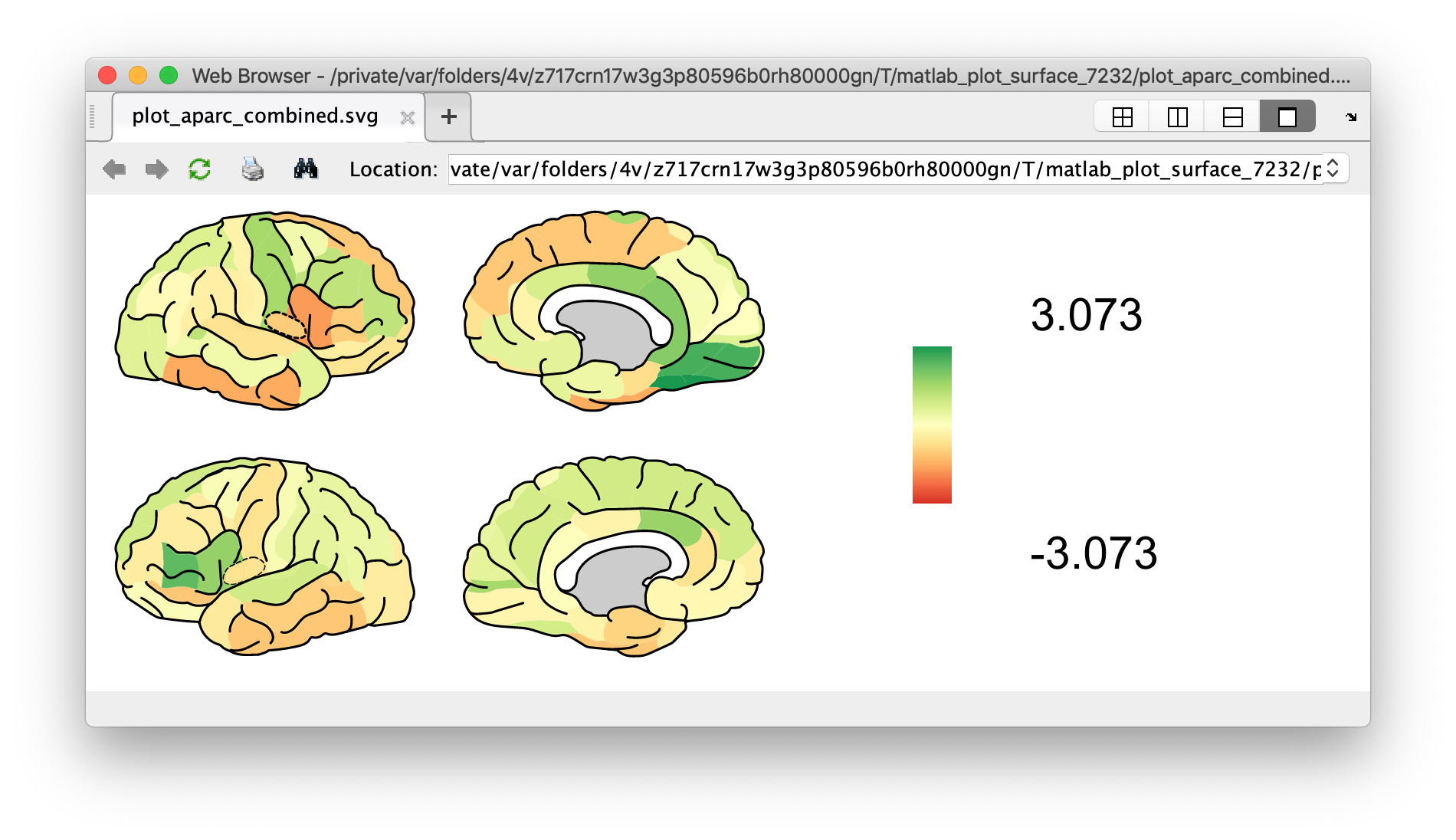brainPlot is a MATLAB function to create simple line-art brain plots.
Atlases available, Installation, Usage, Examples, References, Attribution
This tool can be used to visualize the brain areas in the following atlases:
- ‘Desikan-Killiany’ aparc cortical atlas as present in FreeSurfer [1].
- ‘Desikan-Killiany’ aparc+aseg combined cortical and subcortical atlas as present in FreeSurfer [1].
- 120 regions Cammoun sub-parcellation of the Desikan-Killiany cortical atlas [2].
- 120 regions Cammoun sub-parcellation of the Desikan-Killiany cortical atlas with ASEG subcortical regions [2].
- 250 regions Cammoun sub-parcellation of the Desikan-Killiany atlas [2].
- 39 regions combined Walker-von Bonin and Bailey (WBB47) parcellation atlas of the macaque [3][4][5][6].
- Download/clone this repository and save it in a directory, e.g.
~/MATLAB - Locate the simple-brain-plot directory and add this directory to your MATLAB path using the addpath command:
addpath('~/MATLAB/simple-brain-plot')
- You are ready to use
plotBrain!
Note: When you use the function for the first time, the figure viewer in MATLAB may display "Unable to open file" or "File not found". This error only appears when you use the function for the first time and will be resolved when you try to run it a second time.
plotBrain(regions, values, cm) creates brain plot with regions having
colors as specified by the regions and values vectors with a colormap
defined by the matrix cm. Colormap cm can have any number of rows, but
must have exactly 3 columns.
plotBrain(regions, values, cm, ...) creates brain plots with
optional arguments:
'limits' Two element vector [cmin cmax]. cmin and cmax are assigned
to the first and last color in the colormap.
- default: [min(values) max(values)]
'viewer' A logical indicating whether the created figure will be opened
in web viewer.
- default: true
'savePath' A char array with location and first part of the output file name.
File name will be: ['savePath'_ATLASNAME.svg]
- default: temporary dir, deleted afterwards.
'scaling' A scalar specifying scaling of image. Original scaling is very
large, but smaller scalings show small white lines
- default: '0.1' (10%)
'atlas' Chose which atlas to use
'aparc' - Desikan-Killiany atlas
'aparc_aseg' - Desikan-Killiany atlas + subcortical ASEG
segmentation
'lausanne120' - 120 regions Cammoun sub-parcellation of
the Desikan-Killiany atlas
'lausanne120_aseg' - 120 regions Cammoun sub-parcellation +
subcortical ASEG segmentation
'lausanne250' - 250 regions Cammoun sub-parcellation
'wbb47' - 39 regions combined Walker-von Bonin and Bailey
parcellation atlas of the macaque
- default: 'lausanne120'
First create the colormap you would like to use (one can also use the standard MATLAB colormap). Here we show an example based on the cbrewer YlGnBu-colormap.
cm = [0.8431 0.1882 0.1529; ...
0.9569 0.4275 0.2627; ...
0.9922 0.6824 0.3804; ...
0.9961 0.8784 0.5451; ...
1.0000 1.0000 0.7490; ...
0.8510 0.9373 0.5451; ...
0.6510 0.8510 0.4157; ...
0.4000 0.7412 0.3882; ...
0.1020 0.5961 0.3137];
cm = interp1(cm, 1:0.01:size(cm,1));
Make a folder called "figures" in which the generated figures can be saved.
[~, ~] = mkdir('figures');
Load the names of the brain regions for all atlases.
load('regionDescriptions.mat');
In this example, brain plots are colored using random values. Replace the random values function randn(size(regionDescriptions.ATLAS)), with your own variable to plot your specific values in the brain figure.
plotBrain(regionDescriptions.aparc_aseg, ...
randn(size(regionDescriptions.aparc_aseg)), cm, ...
'atlas', 'aparc_aseg', ...
'savePath', 'examples/figure');
plotBrain(regionDescriptions.aparc_aseg, ...
randn(size(regionDescriptions.aparc_aseg)), cm, ...
'atlas', 'aparc', ...
'savePath', 'examples/figure');
plotBrain(regionDescriptions.lausanne120_aseg, ...
randn(size(regionDescriptions.lausanne120_aseg)), cm, ...
'atlas', 'lausanne120_aseg', ...
'savePath', 'examples/figure');
plotBrain(regionDescriptions.lausanne120_aseg, ...
randn(size(regionDescriptions.lausanne120_aseg)), cm, ...
'atlas', 'lausanne120', ...
'savePath', 'examples/figure');
plotBrain(regionDescriptions.lausanne250, ...
randn(size(regionDescriptions.lausanne250)), cm, ...
'atlas', 'lausanne250', ...
'savePath', 'examples/figure');
plotBrain(regionDescriptions.wbb47, ...
randn(size(regionDescriptions.wbb47)), cm, ...
'atlas', 'wbb47', ...
'savePath', 'examples/figure');
Center the color axis around 0 using the limits option:
values = randn(size(regionDescriptions.aparc_aseg));
plotBrain(regionDescriptions.aparc_aseg, ...
randn(size(regionDescriptions.aparc_aseg)), cm, ...
'atlas', 'aparc', ...
'limits', [-max(abs(values)) max(abs(values))]);
[1] Rahul S. Desikan, Florent Ségonne, Bruce Fischl, Brian T. Quinn, Bradford C. Dickerson, Deborah Blacker, Randy L. Buckner, Anders M. Dale, R. Paul Maguire, Bradley T. Hyman, Marilyn S. Albert, and Ronald J. Killiany. An automated labeling system for subdividing the human cerebral cortex on mri scans into gyral based regions of interest. NeuroImage, 31(3):968–80, 2006. URL: http://www.sciencedirect.com/science/article/pii/S1053811906000437, doi:10.1016/j.neuroimage.2006.01.021.
[2] Leila Cammoun, Xavier Gigandet, Djalel Meskaldji, Jean Philippe Thiran, Olaf Sporns, Kim Q. Do, Philippe Maeder, Reto Meuli, and Patric Hagmann. Mapping the human connectome at multiple scales with diffusion spectrum mri. Journal of Neuroscience Methods, 203(2):386–397, 2012. doi:10.1016/j.jneumeth.2011.09.031.
[3] Lianne H. Scholtens, Ruben Schmidt, Marcel A. de Reus, Martijn P. van den Heuvel. Linking Macroscale Graph Analytical Organization to Microscale Neuroarchitectonics in the Macaque Connectome. Journal of Neuroscience 3 September 2014, 34 (36) 12192-12205; URL: https://www.jneurosci.org/content/34/36/12192.short DOI: 10.1523/JNEUROSCI.0752-14.2014
[4] Stephan KE, Hilgetag CC, Burns GA, O'Neill MA, Young MP, Kötter R. Computational analysis of functional connectivity between areas of primate cerebral cortex. Philos Trans R Soc Lond B Biol Sci 355:111–126, 2000. URL: https://royalsocietypublishing.org/doi/abs/10.1098/rstb.2000.0552 doi:10.1098/rstb.2000.0552, pmid:10703047
[5] von Bonin G, Bailey P. The neocortex of Macaca mulatta. 1947. University of Illinois, Urbana, IL.
[6] Walker EA. A cytoarchitectural study of the prefrontal area of the macaque monkey. J Comp Neurol 73:59–86, 1940. doi:10.1002/cne.900730106
If you find this code useful in your research, please cite as: Scholtens, Lianne H, de Lange, Siemon C, and van den Heuvel, Martijn P. 2021. “Simple Brain Plot”. Zenodo. https://doi.org/10.5281/zenodo.5346593.

